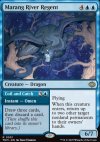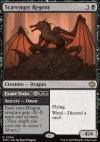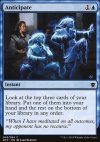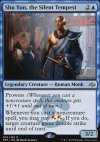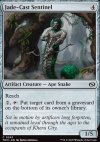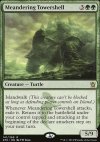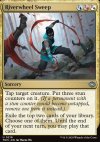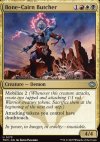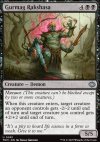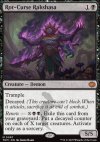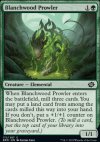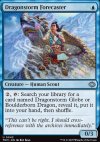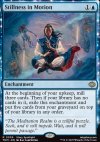|

Archive des News/Articles |
Forum Gazette |
Artgame |
MWS |
MV wiki |
Contact |
Storyline
MAJ Lorwyn éclipsé (17/12)
|
Anecdotes
Général |
OIK |
Échanges |
Règles |
Tournois |
Rumeurs |
Decks |
Vintage |
Legacy |
Modern |
Pioneer |
Standard |
Peasant |
Commander |
Tiny Leaders |
Explorer |
MTG Arena

MV anecdotes
| 47 anecdotes trouvées |   |
Les cinq cartes Clarion Conqueror, Marang River Regent, Scavenger Regent, Magmatic Hellkite et Bloomvine Regent, de l'édition Tarkir: Dragonstorm, forment un cycle de dragons, ceux des couleurs bleue, noire et verte possédant un Omen de la même couleur et étant appelés "Regent".
Source ("Rare - A rare cycle of monocolor Dragons - The blue, black, and green Dragons have an Omen spell.")
Source ("Rare - A rare cycle of monocolor Dragons - The blue, black, and green Dragons have an Omen spell.")
Les cinq cartes Mox Pearl, Mox Sapphire, Mox Jet, Mox Ruby et Mox Emerald, auxquelles s'ajoutent Mox Diamond, Chrome Mox, Mox Tantalite, Mox Opal et Mox Jasper, illustrées par Dan Frazier, forment un cycle d'illustrations (voir aussi cette anecdote).
L'illustration du même artiste pour la carte Mox Poison fait référence à ce cycle.
L'illustration du même artiste pour la carte Mox Poison fait référence à ce cycle.
La carte Ringing Strike Mastery est une référence à Singing Bell Strike de par son nom et son effet.
La carte Rediscover the Way est une référence aux cartes Anticipate et Shu Yun, the Silent Tempest (deux anciennes cartes du bloc Tarkir) de par les effets de ses chapitres.
La carte Rebellious Strike est une référence à Defiant Strike de par son nom, son effet et son texte d'ambiance.
La carte Jade-Cast Sentinel est une référence à Thieving Amalgam de par ses types de créature grand singe et serpent, propres à cette seule espèce de créature originaire de Tarkir.
Search ~ Ape Snake
Search ~ Ape Snake
Le texte d'ambiance de la carte Inevitable Defeat est une référence à celui de la carte Utter End.
Le nom de la carte Afterlife from the Loam est une référence à celui de la carte Life from the Loam.
La carte Ambling Stormshell est une référence à Meandering Towershell de par son nom, son coût de mana, son type de créature et ses force et endurance.
Sur une illustration alternative de Wayne Wu pour la carte Riverwheel Sweep, de l'édition Tarkir: Dragonstorm, le personnage ne porte pas de bandeau sur ses yeux.
Les cartes Gurmag Rakshasa, Rot-Curse Rakshasa, Rakshasa Debaser, Soulhunter Rakshasa, Rakshasa Gravecaller, Rakshasa Deathdealer et Rakshasa Vizier, ainsi que les créatures représentées sur les illustrations des cartes Rakshasa's Disdain et Rakshasa's Secret, font référence aux Rakshasas : des démons à la morphologie multiforme de la mythologie hindoue.
Les cinq cartes Abzan Monument, Jeskai Monument, Sultai Monument, Mardu Monument et Temur Monument, de l'édition Tarkir: Dragonstorm, forment un cycle appelé "Monument" et qui fait référence aux clans de Tarkir, respectivement : Abzan, Jeskai, Sultai, Mardu et Temur (voir cette anecdote) de par leur nom et leur illustration.
Ce cycle est inspiré d'un autre cycle paru dans l'édition Dragons of Tarkir (voir cette anecdote).
Ce cycle est inspiré d'un autre cycle paru dans l'édition Dragons of Tarkir (voir cette anecdote).
La carte Summit Intimidator est une référence à Summit Prowler de par son nom, sa valeur de mana, son type de créature, ses force et endurance et son illustration.
En effet, ni la modification du passé (voir cette anecdote), ni le temps, ni les dragons n'auront raison du yéti : Tarkir aura toujours un yéti...
En effet, ni la modification du passé (voir cette anecdote), ni le temps, ni les dragons n'auront raison du yéti : Tarkir aura toujours un yéti...
Les cartes Bearer of Glory et Voice of Victory, de l'édition Tarkir: Dragonstorm et illustrées par Joshua Cairos, représentent la même scène de deux points de vue différents, en champ-contrechamp.
La carte Ainok Wayfarer est une réimpression fonctionnelle de Blanchwood Prowler, à part pour le type de créature.
Le Dragonstorm Forecaster se tient debout sur un Boulderborn Dragon et tient en main un Dragonstorm Globe, ce qui correspond aux deux cartes de son effet.
À noter que sur son illustration originale par Kev Fang, le Dragonstorm Forecaster porte des lunettes et le Dragonstorm Globe est bleu.
Source
À noter que sur son illustration originale par Kev Fang, le Dragonstorm Forecaster porte des lunettes et le Dragonstorm Globe est bleu.
Source
Les cinq cartes Kin-Tree Severance, Riverwheel Sweep, Rakshasa's Bargain, Defibrillating Current et Dragonclaw Strike, ainsi que les cinq cartes Reputable Merchant, Monastery Messenger, Gurmag Nightwatch, Reigning Victor et Temur Tawnyback, de l'édition Tarkir: Dragonstorm, forment un cycle d'éphémères/rituels tricolores, ainsi qu'un cycle de créatures avec la même intention, avec un coût de mana composé de manas hybrides monochromes (une couleur unique et deux manas génériques), chacun étant rattaché à un des wedges des clans de Tarkir, respectivement : Abzan, Jeskai, Sultai, Mardu et Temur (voir cette anecdote).
Ils peuvent être joués pour uniquement du mana générique, mais coûtent de moins en moins cher en fonction du nombre des couleurs correspondantes des manas qui sont dépensés pour les lancer.
Ce cycle est inspiré d'un autre cycle paru dans l'édition Shadowmoor (voir cette anecdote).
Source (Monocolor Hybrid Mana)
Ils peuvent être joués pour uniquement du mana générique, mais coûtent de moins en moins cher en fonction du nombre des couleurs correspondantes des manas qui sont dépensés pour les lancer.
Ce cycle est inspiré d'un autre cycle paru dans l'édition Shadowmoor (voir cette anecdote).
Source (Monocolor Hybrid Mana)
Les cinq cartes Skirmish Rhino, Jeskai Brushmaster, Lie in Wait, Bone-Cairn Butcher et Mammoth Bellow, de l'édition Tarkir: Dragonstorm, forment un cycle de sorts tricolores peu communs, soutenant chacun un archétype de formats limités et rattachés aux wedges des clans de Tarkir, respectivement : Abzan, Jeskai, Sultai, Mardu et Temur (voir cette anecdote).
Source ("Draft, as an example, had a big influence on the uncommon gold cards that model Draft archetypes")
Source ("Draft, as an example, had a big influence on the uncommon gold cards that model Draft archetypes")
Les cinq cartes Revival of the Ancestors, Rediscover the Way, Awaken the Honored Dead, Thunder of Unity et Roar of Endless Song, de l'édition Tarkir: Dragonstorm, forment un cycle de Sagas tricolores, chacune étant rattachée à un des wedges des clans de Tarkir, respectivement : Abzan, Jeskai, Sultai, Mardu et Temur (voir cette anecdote).
Les cinq cartes Armament Dragon, Jeskai Shrinekeeper, Kheru Goldkeeper, Sonic Shrieker et Karakyk Guardian, de l'édition Tarkir: Dragonstorm, forment un cycle de dragons tricolores, chacun étant rattaché à un des wedges des clans de Tarkir, respectivement : Abzan, Jeskai, Sultai, Mardu et Temur (voir cette anecdote).
Source ("Uncommon [...] A cycle of three-color Dragons")
Source ("Uncommon [...] A cycle of three-color Dragons")
Cinq cartes de l'édition Tarkir: Dragonstorm portent la mention Story Spotlight.
• Rally the Monastery
• Stillness in Motion
• Narset's Rebuke
• Sarkhan's Resolve
• Call the Spirit Dragons
• Rally the Monastery
• Stillness in Motion
• Narset's Rebuke
• Sarkhan's Resolve
• Call the Spirit Dragons
| 47 anecdotes trouvées |   |





 Avatar: the Last Airbender
Avatar: the Last Airbender Spider-Man / Omenpaths
Spider-Man / Omenpaths Edge of Eternities
Edge of Eternities Final Fantasy
Final Fantasy Tarkir: Dragonstorm
Tarkir: Dragonstorm Aetherdrift
Aetherdrift Foundations
Foundations
